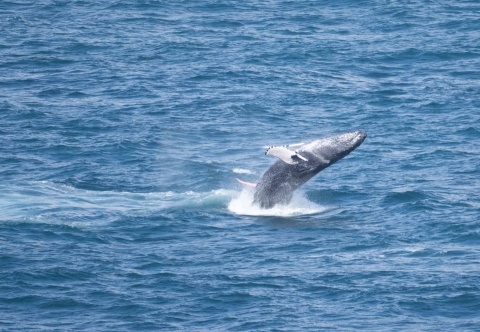What We Do
Kīlauea Point National Wildlife Refuge is managed to:
- Protect and enhance migratory seabirds and the threatened nēnē (Hawaiian goose) populations and their habitats;
- Preserve and maintain the historical integrity of the area, including the Daniel K. Inouye Kīlauea Point Lighthouse and Light Station, which was listed on the National Register of Historic Places in 1979.
- Conduct interpretation and environmental education activities on the National Wildlife Refuge System as well as Hawaiian flora and fauna, nature conservation, site history, and site geology.
- Protect and enhance native coastal plant communities
Our Projects and Research
Seabird Research at Kilauea Point NWR - In Partnership with USGS
Population Estimates for Selected Breeding Seabirds at Kīlauea Point National Wildlife Refuge, Kauaʻi, in 2019
Kīlauea Point National Wildlife Refuge (KPNWR) is an important seabird breeding site located at the northeastern tip of Kauaʻi in the main Hawaiian Islands. Despite the regional significance of KPNWR as one of the most important breeding sites for red-tailed tropicbirds (Phaethon rubricauda), red-footed boobies (Sula sula), and wedge-tailed shearwaters (Ardenna pacifica) in the main Hawaiian Islands, robust and accurate population surveys have not been consistently conducted and recent information is lacking. In this study, we completed comprehensive population surveys for these three species during the 2019 breeding season. Using direct censusing methods (ground-searching, visual and photographic counts), we determined that 387 red-tailed tropicbird and 5,049 red-footed booby breeding pairs nested at KPNWR in 2019. Additionally, we performed surveys of aerially displaying tropicbirds to estimate a potential population of 30 white-tailed tropicbird (Phaethon lepturus) breeding pairs at KPNWR. Using a stratified-random plot-sampling method, we estimated that 20,998 wedge-tailed shearwater pairs nested at KPNWR in 2019. The breeding population size results in this study are greater than those reported in the past for KPNWR. We suggest that the red-tailed tropicbird breeding population has increased since the mid-2000s (when population estimates were last made), whereas red-footed booby numbers likely have remained similar and 2019 results show an increase from past estimates because of the more comprehensive methods used in this study. The results of these surveys provide current and accurate population sizes for these species that can serve as (1) benchmarks for future management and monitoring at KPNWR and (2) important components of population-level assessments of seabird vulnerability to potential offshore wind energy development in the main Hawaiian Islands
Habitat Affinities and At-Sea Ranging Behaviors among Main Hawaiian Island Seabirds: Breeding Seabird Telemetry, 2013–2016
Recent Hawaiʻi state clean energy policy mandates and federal interest in developing offshore renewable energy resources have prompted unsolicited lease requests for offshore wind energy infrastructure (OWEI) to be located in ocean waters off Hawaiʻi. This study describing at-sea ranging behaviors for five seabirds was intended to provide new information on Hawaiian breeding seabird distribution at sea, habitat utilization, and ranging behaviors within near-island waters and throughout outer continental shelf (OCS) waters surrounding the main Hawaiian Islands (MHI).
Other Projects
Native Hawaiian Cultural Practice
In our effort to perpetuate Hawaiian ancestral knowledge, philosophies, and practices, we work together with Kaʻipuwai Foundation, Halau Palaihiwa O Kaipuwai, and Nā Kiaʻi Nihokū. These organizations perpetuate Native Hawaiian cultural practices and work to support place-based understanding and appreciation of wildlife education and conservation.
Hawaiian Islands Humpback Whale NMS - NOAA Ocean Count
The Sanctuary Ocean Count is a signature outreach and citizen science project that offers the community – locals and visitors alike – a chance to monitor humpback whales from the shores of Oʻahu, Hawaiʻi and Kauaʻi. The count is conducted three times per year during peak whale season and provides a snapshot of humpback whale sightings from the shoreline.
The count is held the last Saturday of January, February, and March of each year from 8:00 a.m. to 12:15 p.m. The Ocean Count promotes public awareness about humpback whales, the sanctuary, and shore-based whale watching opportunities in the Hawaiian Islands. The Great Whale Count takes place on the same dates on Maui, led by the Pacific Whale Foundation.
To get involved or see annual project results, visit NOAA Ocean Count website.




